In America, the Episcopal and Methodist churches are big names in Christianity. They have their own history, beliefs, and ways of worship. But what makes them different? Let’s find out.
As we explore, a key question comes up: What are the main differences between the Episcopal and Methodist churches? How do these differences affect their followers’ religious lives?
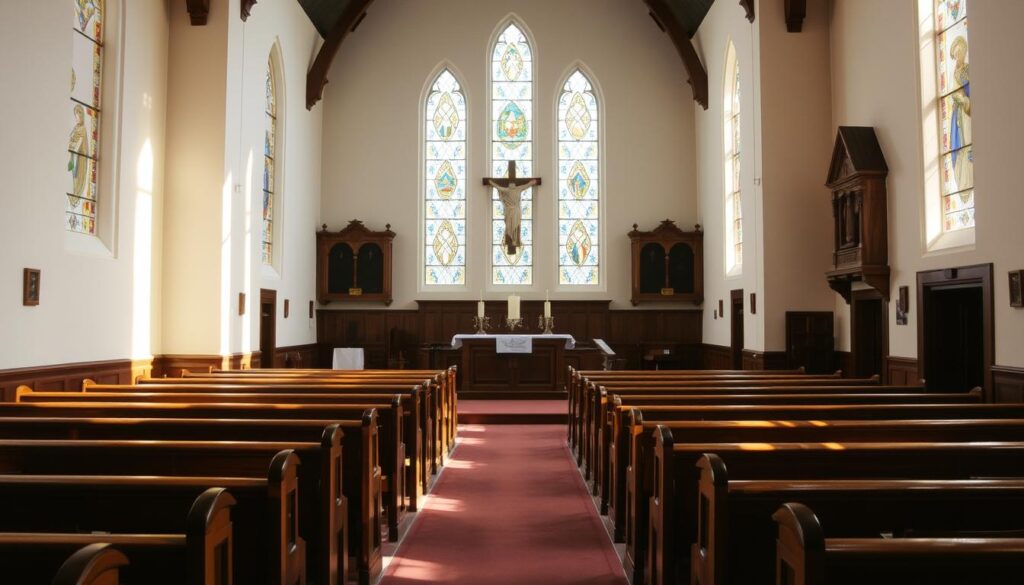
Key Takeaways
- The Episcopal Church is the largest Anglican communion in America, with around 2 million members, while the United Methodist Church is the largest Methodist denomination, with 7.6 million members.
- Episcopalians and Methodists share some beliefs and practices. Both are part of the Reformation Protestantism. But they differ in their theology, worship, and views on social issues.
- The Episcopal Church leans towards being socially and theologically liberal. The United Methodist Church has faced debates over LGBTQI inclusion and same-sex marriage.
- Methodists believe in Arminian theology, which focuses on salvation by grace through faith. This is different from Calvinist or Reformed beliefs.
- The Episcopal and Methodist churches have their own ways of making decisions. The Episcopal Church’s General Convention and the United Methodist Church’s General Conference are key in this process.
Introduction to Episcopal and Methodist Churches
The Episcopal Church and the United Methodist Church have their roots in the Church of England. They share a common heritage but have grown into unique churches. This happened as they adapted to the religious scene in the United States.
Brief Overview of the Two Christian Denominations
The Episcopal Church is part of the Anglican Communion worldwide. It started in the Church of England but became independent in the United States after the American Revolution.
The United Methodist Church, however, is part of the Methodist tradition. John Wesley founded the Methodist movement in the Church of England. It later became its own church.
Historical Roots and Split from the Church of England
Both churches have roots in the Church of England but have grown differently. The Episcopal Church stayed close to the Anglican Communion. The Methodist movement became its own church.
The Methodist Episcopal Church grew fast in the early 19th century. It became the biggest church in the United States. But, it split in 1845 over slavery issues, creating the Methodist Episcopal Church, South.
Over time, the Methodist Church went through changes. In 1968, it merged with the Evangelical United Brethren Church to become the United Methodist Church.
| Denomination | Congregations | Membership | Ministers | Founding |
|---|---|---|---|---|
| Methodist Episcopal Church | 24,295 (1937) | 4.4 million (1937) | 15,741 (1935) | December 1784, Baltimore, Maryland |
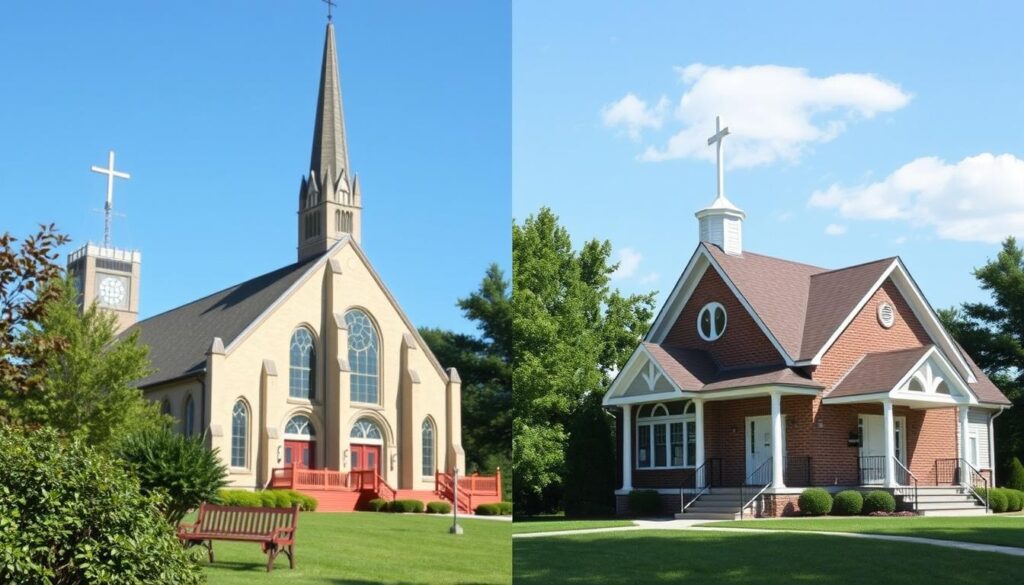
“The Methodist Episcopal Church became the largest and most influential religious denomination in the United States in the early 19th century.”
Shared Beliefs and Practices of Episcopal and Methodist
The Episcopal and Methodist churches have many things in common. They both follow the Apostles’ and Nicene Creeds, which are key to Christian faith. They also agree on the same Bible and celebrate baptism and Holy Communion as important parts of their faith.
Common Creeds, Scriptures, and Sacraments
Both churches believe in the Apostles’ and Nicene Creeds. They also agree on the 66 books of the Protestant Bible. When it comes to sacraments, they both value baptism and Holy Communion, even if they see them differently.
Commitments to Christian Life and Mission
- They both focus on living a holy life and serving others.
- They are passionate about fighting for justice and spreading the gospel worldwide.
- They encourage their members to help others and share the gospel.
Even though they have different histories, the Episcopal and Methodist churches share a lot. They agree on key beliefs, sacraments, and the importance of living out Christ’s teachings. This shared foundation helps them work together and understand each other better.
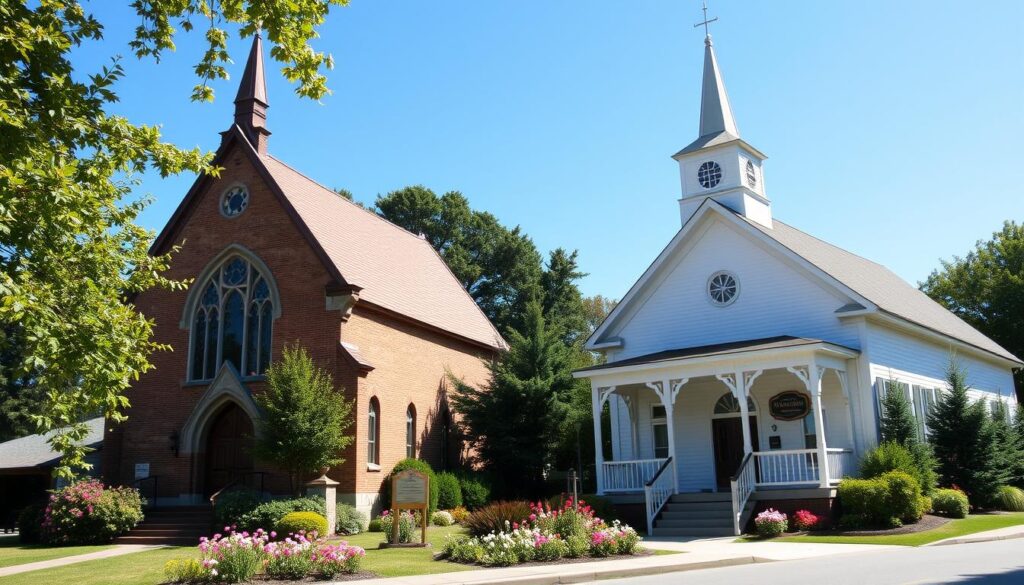
What is Full Communion?
In 2006, the Episcopal Church and United Methodist Church formed a relationship called “full communion.” This means they accept each other’s baptisms, church memberships, and ordinations. This allows them to work together more closely and share ordained ministers.
Mutual Recognition of Baptism, Membership, and Ordinations
Episcopal priests can now serve in United Methodist churches, and vice versa. They must follow the rules of the church they are in. This makes it easier to share clergy and strengthens both churches’ ministries.
Interchangeability of Ordained Ministers
The United Methodist Church’s General Conference voted 95 percent in favor of full communion with the Episcopal Church. This partnership lets the two churches share clergy and work together more effectively.
| Denomination | Communion Agreements |
|---|---|
| Episcopal Church | Evangelical Lutheran Church in America Moravian Church Mar Thoma Syrian Church of Malabar Old Catholic Churches of the Union of Utrecht Philippine Independent Church Church of Sweden |
| United Methodist Church | Episcopal Church (proposed) Moravian Church (northern and southern provinces) |
The full communion between the Episcopal Church and United Methodist Church is a big step. It brings unity and cooperation to the Christian community.
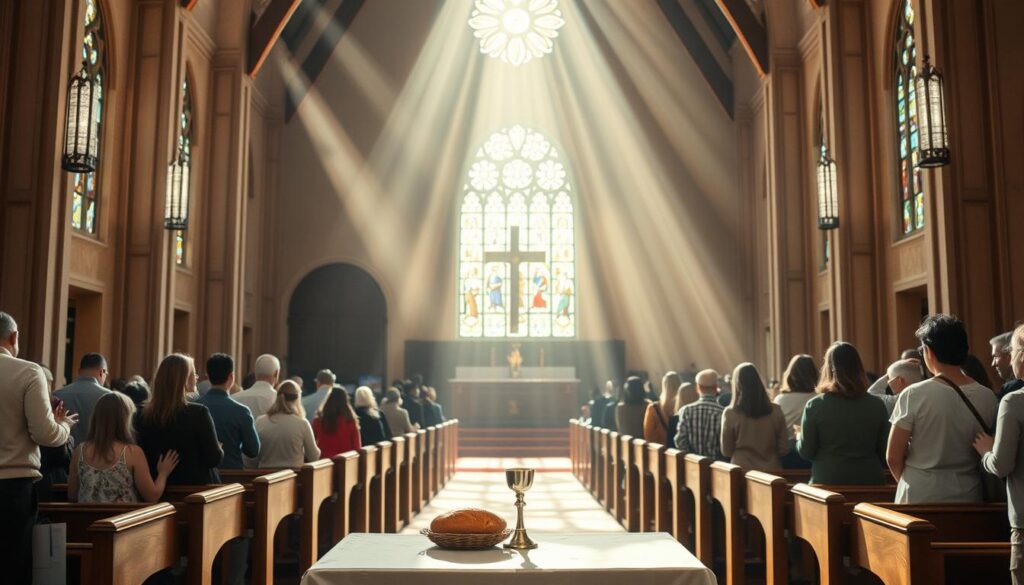
Differences in Worship and Liturgy
The Episcopal Church and the United Methodist Church have different ways of worship and liturgy. Both share a deep Christian heritage. Yet, their practices and tools for services vary a lot.
Episcopal Church and the Book of Common Prayer
The Episcopal Church bases its worship on the Book of Common Prayer. This book is key to their services, guiding everything from the service order to specific prayers. The Eucharist is a key part of their worship, held weekly or daily in many places.
United Methodist Church and the Book of Worship
The United Methodist Church relies on the Book of Worship for its services. This book offers more flexibility, letting churches tailor their services to their needs. While Holy Communion is significant, it’s not as common in all United Methodist churches as in the Episcopal Church.
These differences show the theological and historical gaps between the two denominations. They reflect the unique traditions and ongoing discussions within each community.
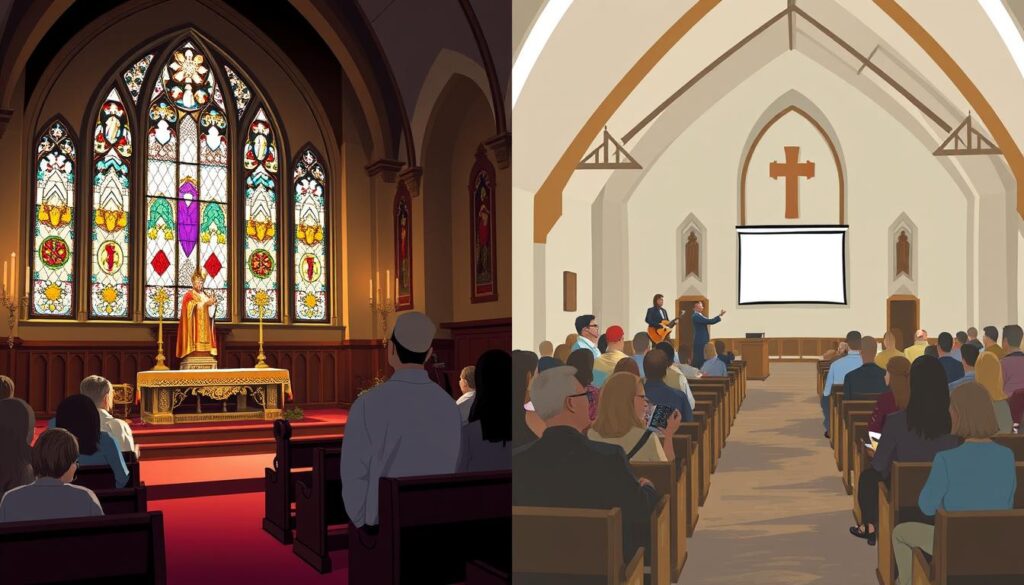
Episcopal vs Methodist: Understanding Holy Communion
The Episcopal Church and the United Methodist Church share many beliefs. Yet, their views on the Eucharist, or Holy Communion, show some key differences. Both affirm Christ’s real presence in the sacrament, but they focus differently.
The Episcopal Church’s View of the Eucharist
For Episcopalians, the Eucharist is the heart of worship. It centers on Christ’s death and resurrection. They believe Christ is truly present in the sacrament and welcome all baptized Christians to receive communion.
The Episcopal Church sees the Eucharist as very important. They often celebrate it every Sunday.
READ: BSF John Lesson 29 Day 4
The United Methodist Church’s Beliefs on the Eucharist
United Methodists also believe in Christ’s real presence in the Eucharist. But they focus a bit differently. The Eucharist’s importance and how often it’s celebrated vary among United Methodist churches.
Some United Methodist churches celebrate communion weekly. Others do it less often.
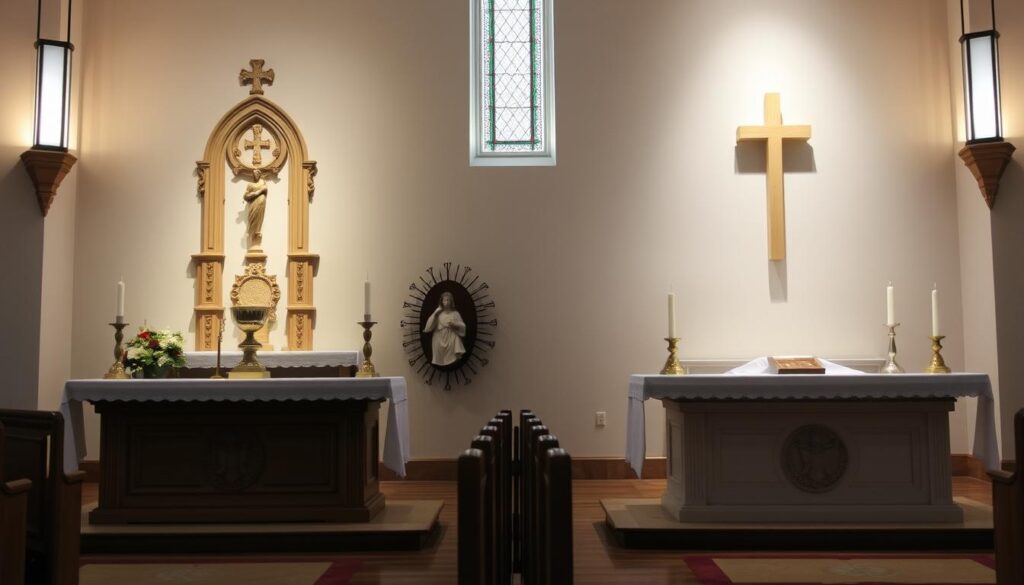
Both the Episcopal Church and the United Methodist Church see the Eucharist as a special and changing experience. Their views and practices around this sacrament show their unique histories and traditions.
Wine and Grape Juice in Communion
The Episcopal Church and the United Methodist Church have different ways of celebrating Holy Communion. The Episcopal Church uses wine, following the Book of Common Prayer. On the other hand, the United Methodist Church prefers unfermented grape juice.
This difference started in the late 19th century. Dr. Thomas B. Welch created unfermented grape juice for Communion in 1869. The United Brethren in Christ and later the Methodist Episcopal Church adopted it in 1916. This change was influenced by the temperance movement, which favored grape juice over wine.
| Denomination | Communion Element |
|---|---|
| Episcopal Church | Wine |
| United Methodist Church | Grape Juice |
Even with these differences, the Episcopal and United Methodist Churches can share in Communion together. They agree to use both wine and grape juice in their joint celebrations. This shows respect for each other’s traditions and promotes unity.
The debate over grape juice versus wine in Communion usually focuses on personal taste or tradition. The Episcopal Church sticks to wine, while the United Methodist Church prefers grape juice. Yet, the full communion agreement respects both choices, acknowledging their historical and cultural backgrounds.
LGBTQI Inclusion and Marriage
The Episcopal Church and the United Methodist Church have different views on LGBTQI inclusion and same-sex marriage. The Episcopal Church allows same-sex couples to get married, with most dioceses supporting these ceremonies. This is a big difference from the United Methodist Church, which bans same-sex marriage and the ordination of openly LGBTQI individuals.
Episcopal Church’s Stance on Same-Sex Marriage
The Episcopal Church in the US has 2 million members and spans nine provinces. In 1976, the church voted to be inclusive of all sexual orientations and gender identities. The church officially supports same-sex marriage with votes in 2015 and 2018. In 2018, the General Convention approved Resolution B012, making marriage rites for same-sex couples available in all dioceses.
United Methodist Church’s Position on LGBTQI Issues
The United Methodist Church (UMC) has 12.5 million members worldwide, with 7 million in the United States. The denomination’s Book of Discipline bans support for LGBTQ+-based groups. In 2016, delegates voted to delay action on LGBTQ+ issues. In February 2019, the “Traditionalist Plan” was approved, reaffirming the church’s stance on homosexuality.
The Traditional Plan introduces new penalties for ministers who perform same-sex weddings. It includes a minimum one-year suspension without pay for the first wedding and permanent removal for the second. The United Methodist Church does not recognize or celebrate same-sex marriages. Ceremonies celebrating homosexual unions are not allowed in UMC churches or performed by UMC ministers.
However, there is ongoing debate and disagreement within the United Methodist denomination on these issues. Some congregations and clergy openly support LGBTQI inclusion.
| Episcopal Church | United Methodist Church |
|---|---|
| Authorized rites for Christian marriage of same-sex couples, with most dioceses allowing for the performance of these ceremonies. | Prohibits same-sex marriage and the ordination of openly LGBTQI individuals. The Book of Discipline contains language that prohibits homosexuality and same-sex marriage. |
| Codified theological support for same-sex marriage with resolutions passed in 2015 and 2018. | Reaffirmed its ban on marriage equality at the 2019 special conference. |
| Approved transgender ordination at its 2012 General Convention. | Gay, lesbian, and bisexual individuals who take a vow of abstinence are eligible for ordination according to church law. |
“The Episcopal Church supports non-discrimination and includes sexual orientation, gender identity, and expression as specifically protected from discrimination.”
Episcopal and Methodist Church Governance and Decision-Making
The Episcopal Church and the United Methodist Church have different ways of making decisions. They both follow Christianity but have their own ways of leading their churches.
Episcopal Church’s General Convention
The Episcopal Church’s top decision-making body is the General Convention. It meets every three years. It has two parts: the House of Bishops and the House of Deputies.
The House of Deputies includes both clergy and lay people. This mix helps balance the church’s decisions. The General Convention sets policies and guides the church’s direction.
United Methodist Church’s General Conference
The United Methodist Church’s top body is the General Conference. It meets every four years. It’s made up of clergy and lay delegates.
This group decides on church policies. It’s the only one that can officially speak for the United Methodist Church. This ensures a unified approach to leadership.
| Characteristic | Episcopal Church | United Methodist Church |
|---|---|---|
| Highest Legislative Authority | General Convention (meets every 3 years) | General Conference (meets every 4 years) |
| Decision-Making Structure | Bicameral (House of Bishops and House of Deputies) | Clergy and lay delegates |
| Scope of Authority | Establishes policies, liturgies, and other important matters | Establishes policies and decisions that affect the entire denomination |
Both churches have strong systems for making decisions. These systems reflect their unique histories and beliefs. They shape how each church is led and governed.
Ministry Orders and Roles
The Episcopal Church and the United Methodist Church have their own ways of organizing ministry. They have different orders of ministry that show their beliefs and structures. These roles are key to the life and leadership of each church.
Episcopal Orders of Ministry
The Episcopal Church has four main ministry orders: the laity, deacons, priests, and bishops. This setup shows the church’s view on the episcopacy and the value of ordained clergy. The laity, all baptized members, are called to join in the church’s mission. Deacons act as a link between the church and the world. Priests lead worship, preach, and handle sacraments. Bishops are the top leaders, guiding the clergy and the diocese.
United Methodist Orders of Ministry
The United Methodist Church has three main ministry orders: the laity, deacons, and elders (which means priests). The laity, all baptized members, are called to join in the church’s mission. Deacons connect the church to the world. Elders lead worship, preach, handle sacraments, and manage congregations. Bishops are leaders in the denomination, overseeing clergy and the church.
| Episcopal Church | United Methodist Church |
|---|---|
| 4 Orders of Ministry: Laity, Deacons, Priests, Bishops | 3 Orders of Ministry: Laity, Deacons, Elders |
| Bishops serve as chief pastors, overseeing the clergy and diocese | Bishops serve as consecrated leaders, overseeing the clergy and church |
| Deacons serve as a bridge between the church and the world | Deacons serve to connect the church to the world |
| Priests lead worship, preach, and administer sacraments | Elders lead worship, preach, administer sacraments, and oversee congregations |
The Episcopal Church and the United Methodist Church see ordained ministry differently. These views show their unique histories, theologies, and church structures.
Historical Perspectives on Doctrinal Differences
The Episcopal and Methodist churches have different beliefs because of their history. They have grown in different ways in the United States. This has shaped their unique identities.
American Methodism split since its start in 1784. This was due to disagreements on church leadership, beliefs, and worship. The Methodist Church in America was officially formed on February 28, 1784. This was because of the Treaty of Paris in October 1783, ending the Revolutionary War and breaking ties with the Church of England.
The first big split was in 1828 over church leadership. This led to the Methodist Protestant Church forming. In 1844, a major split happened over slavery. The Methodist Episcopal Church South was formed by southern churches that supported slavery and believed in white supremacy.
In 1939, the Methodist Episcopal Church, the Methodist Episcopal Church South, and the Methodist Protestant Church merged. They created the Methodist Church. They agreed to keep all-black churches separate in a Central Jurisdiction. The 1968 merger with the Evangelical United Brethren formed the United Methodist Church. But, big disagreements still existed.
Methodists have always had different views on social and theological issues. These include slavery, race, war, sexuality, and women’s roles. Despite these differences, Methodists have valued diversity. They use a method called the Wesley Quadrilateral, which includes scripture, reason, tradition, and experience.
The plan for full communion between the Episcopal and United Methodist Churches aims to end a long division. Over time, Episcopalians and Methodists have grown closer. But, both denominations face challenges like shrinking and aging memberships.
Ecumenical Efforts and Future Outlook
The Episcopal and Methodist churches have worked together despite their differences. They signed a full communion agreement in 2006. This has helped them understand each other better and work together more closely.
The United Methodist Church agreed to full communion with the Episcopal Church. But the Episcopal Church won’t vote on it until 2027. This delay has changed plans for separating and working together more closely.
A proposal for full communion, called “A Gift to the World,” has been made. It aims to bring the churches closer together. But it doesn’t talk about LGBTQ inclusion, a big issue for them.
The United Methodist Church has agreements with other churches too. They work with the Evangelical Lutheran Church in America and the Uniting Church in Sweden. They also work with historically Black Pan-Methodist denominations and the Moravian Church in North America. Their dialogue with the Episcopal Church started in 2002.
Even with challenges, the Episcopal and Methodist churches keep working together. They aim to understand each other better and work together. Their efforts show their commitment to unity, even with differences.
Celebrating Diversity Within Christianity
The Episcopal and Methodist churches are part of a larger Christian family in the United States. They show how different groups can work together. This highlights the beauty of various ways to share the Gospel and help others.
The Episcopal Church is known for its open views on many issues. The United Methodist Church, with millions of members worldwide, is also exploring new paths. This includes how to welcome everyone, no matter their sexual orientation.
Despite their differences, these churches have a long history of working together. They have agreed to recognize each other’s clergy and baptisms. This shows their commitment to being united as Christians.
As the United Methodist Church considers splitting, lessons from the Episcopal Church can help. The diversity in Christianity is a chance to celebrate different views. It shows how together, they can spread the Gospel and help the world.
| Denomination | Membership | Stance on LGBTQI Issues | Governance |
|---|---|---|---|
| Episcopal Church | 1.8 million (USA) | Affirming of LGBTQI individuals and same-sex marriage | General Convention |
| United Methodist Church | 12 million (USA), 80 million (global) | Divided on LGBTQI issues, potential for split | General Conference |
The Episcopal and Methodist churches remind us that diversity is a strength. By embracing their differences and shared mission, they enrich the Christian community. They show us how to celebrate our differences and work together for a common goal.
Conclusion
The Episcopal and Methodist churches share a common heritage and many beliefs. Yet, they have developed unique views over time. It’s important to understand these differences to appreciate the diversity in American Christianity.
This understanding helps in fostering unity among Christian denominations. As the Episcopal Church and United Methodist Church move towards full communion, challenges lie ahead. The process of clergy interchangeability is expected to take at least three years.
There are debates within the United Methodist Church on LGBTQ inclusivity and reproductive choice. Yet, the proposed framework for full communion is a significant step. It shows the way towards unity and cooperation between these two denominations.
The diversity in American Christianity should be celebrated. It shows the rich variety of faith and how people connect with the divine. By embracing this diversity and finding common ground, the Episcopal and Methodist churches can be models for others.
They demonstrate the power of collaboration and mutual understanding. This pursuit can lead to a more just and equitable world.
FAQ
What are the key differences between the Episcopal and Methodist churches?
The Episcopal and Methodist churches are both Protestant denominations. They started from the Church of England but have grown differently. They disagree on the Eucharist, episcopacy, and LGBTQI issues.
What is the historical relationship between the Episcopal and Methodist churches?
Both churches came from the Church of England. The Episcopal Church became independent after the American Revolution. The Methodist movement, led by John Wesley, split off to form its own church.
What are the similarities in beliefs and practices between the two denominations?
Despite their differences, both churches share many beliefs. They agree on the Apostles’ and Nicene Creeds and the biblical canon. They also value baptism, Holy Communion, and Christian living.
What is the relationship of “full communion” between the Episcopal and Methodist churches?
In 2006, the Episcopal and Methodist churches agreed to “full communion.” This means they recognize each other’s baptisms and ordinations. It helps them work together more closely.
How do the Episcopal and Methodist churches differ in their worship and liturgy?
The Episcopal Church focuses on the Eucharist in its worship. The Methodist Church allows for more varied worship styles. The Eucharist is not as central in Methodist worship.
How do the Episcopal and Methodist churches differ in their views on LGBTQI inclusion and same-sex marriage?
The Episcopal Church supports same-sex marriage. Most dioceses allow these ceremonies. The Methodist Church does not allow same-sex marriage or the ordination of LGBTQI individuals. However, there is ongoing debate within the Methodist Church.
How do the Episcopal and Methodist churches differ in their church governance and decision-making processes?
The Episcopal Church has a General Convention every three years. It has two houses: bishops and deputies. The Methodist Church’s General Conference meets every four years. It includes clergy and lay delegates.
What are the differences in ministry orders and roles between the two denominations?
The Episcopal Church has four ministry orders: laity, deacons, priests, and bishops. The Methodist Church has three: laity, deacons, and elders. Methodist bishops are consecrated leaders.

